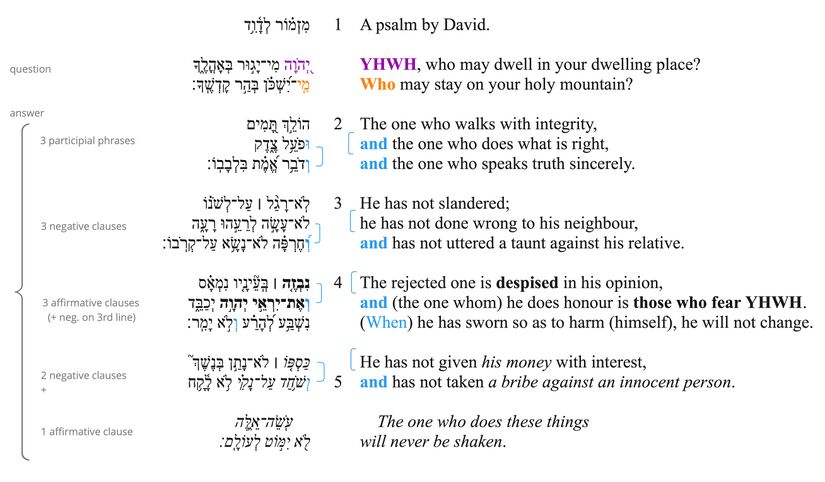Psalm 15 Discourse: Difference between revisions
From Psalms: Layer by Layer
| Line 8: | Line 8: | ||
=Macrosyntax= | =Macrosyntax= | ||
[[File:Psalm 15 - Macrosyntax.jpg|class=img-fluid|825px]] | [[File:Psalm 15 - Macrosyntax.jpg|class=img-fluid|825px]] | ||
*'''v. | |||
This psalm has very simple syntax. | |||
* '''v. 1'''. The repeated question frames the entire psalm, which answers the 'who may dwell' question. | |||
* '''v. 2'''. Verse two begins with sentence fragments, directly answering 'who?' Technically, each fragment would be marked for focus, if it were part of a full clause. Because they're just fragments, they've been left unmarked. | |||
* '''v. 4'''. There are four clauses, but the final two are on one poetic line. The final two have been placed on the same line with the conjunction coloured. | |||
* '''v. 5b'''. This is one clause with an embedded participial phrase, placed on its own simply to acknowledge its verbal nature. | |||
=Speech Act Analysis= | =Speech Act Analysis= | ||
Revision as of 17:53, 30 December 2022
Back to Psalm 15
Macrosyntax
This psalm has very simple syntax.
- v. 1. The repeated question frames the entire psalm, which answers the 'who may dwell' question.
- v. 2. Verse two begins with sentence fragments, directly answering 'who?' Technically, each fragment would be marked for focus, if it were part of a full clause. Because they're just fragments, they've been left unmarked.
- v. 4. There are four clauses, but the final two are on one poetic line. The final two have been placed on the same line with the conjunction coloured.
- v. 5b. This is one clause with an embedded participial phrase, placed on its own simply to acknowledge its verbal nature.
Speech Act Analysis

For Visual, click "Expand" to the right



